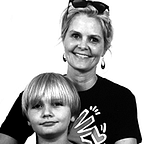Design it Forward
We bring multidisciplinary students together with leading nonprofit organizations to design a better future
Gone are the days when being a designer in tech meant dry conference calls with developers and pixel-pushing marathons. The industry has created endless opportunities to design for good. Whether it be in the interest of sustainability, ethics, or accessibility, opportunities to do good via design are plentiful.
If you’re a designer or a design educator, this article will offer tips on how to make connections and work together as a team to build an educational framework.
One of the most humbling experiences for me, as a designer, has been participating in the Design it Forward program. A partnership between IBM and NC State University’s College of Design, the course was developed by Steve Kim, design director of AIOps & Management at IBM and Dr. Lu Lui, the dean of the College of Graphic and Industrial Design at NC State. Design it Forward helps nonprofits in the Research Triangle Park (RTP) area in North Carolina solve complex problems through design thinking. The students, in turn, gain experience creating real-world design solutions for the nonprofit clients.
Taking it personally
Having been born and lived in Raleigh for the last 30 years, I’ve become very personally connected to this program. It gives me visibility into my community that I’d otherwise not be exposed to — the halfway house a few blocks from my home, the Foster Family Alliance that helps children manage Individualized Education Plans in the school system where I do the same, and the Marbles Kids Museum, where my child attends summer camp.
The process
The process starts with a call for applications from the nonprofits. The NC State and IBM teams review the applications together to select applicants whose needs best fit the program goals. Whether it’s organizations that help the homeless, newly homed, or children in those environments, this is where the relationship between instructor and nonprofit begins.
After conducting interviews with several nonprofits, the next step is perhaps the most difficult: selecting only two or three to support with the program. While they’re all deserving, only a couple nonprofits whose challenges align best with the model of the class can be selected.
The first part of the semester is focused on ensuring the students have a solid understanding of the Enterprise Design Thinking framework. Although most of them are studying design, the class is open to students from other disciplines as well. This is an intentional effort aimed at creating diverse, empowered teams to meet the nonprofits’ challenges.
Next, the students invites the nonprofits to a class to pitch their problem statements. The students vote on which nonprofit they’d like to work with, but ultimately, the instructors divide the students into well-balanced teams. Each team of students works with one instructor for the duration of the semester.
The students develop relationships with representatives from their nonprofits. They interview users of the nonprofit’s services and are responsible for three playbacks during the semester: Research, Hills, and Final playbacks. Although they complete most work outside of class, students can workshop, iterate, diverge, and converge during classes. Seeing the students’ passion for their projects is energizing, and watching them form relationships with one another is just as rewarding, too.
The payoff
Representatives from each nonprofits are invited back for the Final Playback. In Design Thinking terms, a playback is the opportunity to share with your stakeholders, or your teammates, what you’ve learned and what your team is planning. In the three semesters I’ve participated in the course, I’ve never attended a Final Playback where the stakeholders weren’t truly delighted by the student’s innovative ideas. More often than not, the nonprofits go on to implement the students’ designs in one form or another.
Tips on university engagement
As in most aspects of life, becoming engaged with a school is all about relationships. You might have to start from the ground up, but remember, your industry expertise is valuable. If you hear of a university engagement opportunity from your company or alma mater or on social media, jump on it. It may be a simple instructional event or workshop, but a big benefit is making contacts.
Once you’ve cultivated a relationship with representatives at the school, you don’t need to create a program on your own. Gather colleagues who can contribute and work together with the school to understand the culture and students’ needs. While the students will certainly benefit from what you have to offer, you may find that the one who gets the most out of the experience is you.
If you’re affiliated with a nonprofit in RTP area, you can submit a project brief on the Design it Forward sponsor page.
Design it Forward wouldn’t be what it is today without the hard work and expertise of IBM guest instructors, including Brian Burnette, Kara Kotwas, Jillian Quiller, Clay Braxton, Zach Nilsson, Kristine Berry, and Kevin Schultz.
Kim Holmes is a user experience designer at IBM based in Raleigh, North Carolina. The above article is personal and does not necessarily represent IBM’s positions, strategies, or opinions.
